If you're looking to add a vibrant burst of color to your garden, consider incorporating bell-shaped flowers into your plant collection. These stunning blooms bring a touch of elegance and charm while infusing your garden with a wide variety of fragrances.
From the rich purples of Fritillaria to the delicate pinks of Campanula, the diverse range of bell-shaped flowers offers an array of options to suit your color preferences and garden design. From garden beds to hanging baskets beautiful bell shaped flowers are a perfect addition to your backyard landscape.
- Why Should I Choose Bell Shaped Flowers?
- Persian Lily
- Blue Bell
- Lily of the Valley
- Campanula Bellflower
- Foxglove
- Harebell
- Canterbury Bells
- Fritillaria meleagris (Snake's Head Fritillary)
- Trumpet Vine
- Columbine
- Gloxinia
- White Mountain Heather
- Lady's Slipper Orchid
- Beardtongue
- Daffodil
- Bell Shaped Flowers Conclusion
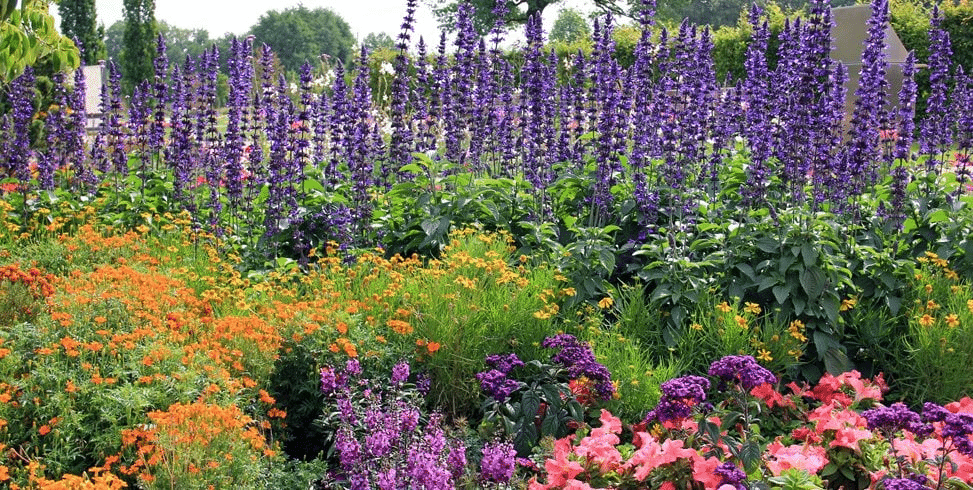
Why Should I Choose Bell Shaped Flowers?
Bell shaped flowers offer a range of compelling reasons to be planted in your garden. Their graceful aesthetic appeal adds elegance and sophistication to any landscape, whether in formal or cottage-style gardens, or balcony mini-gardens.
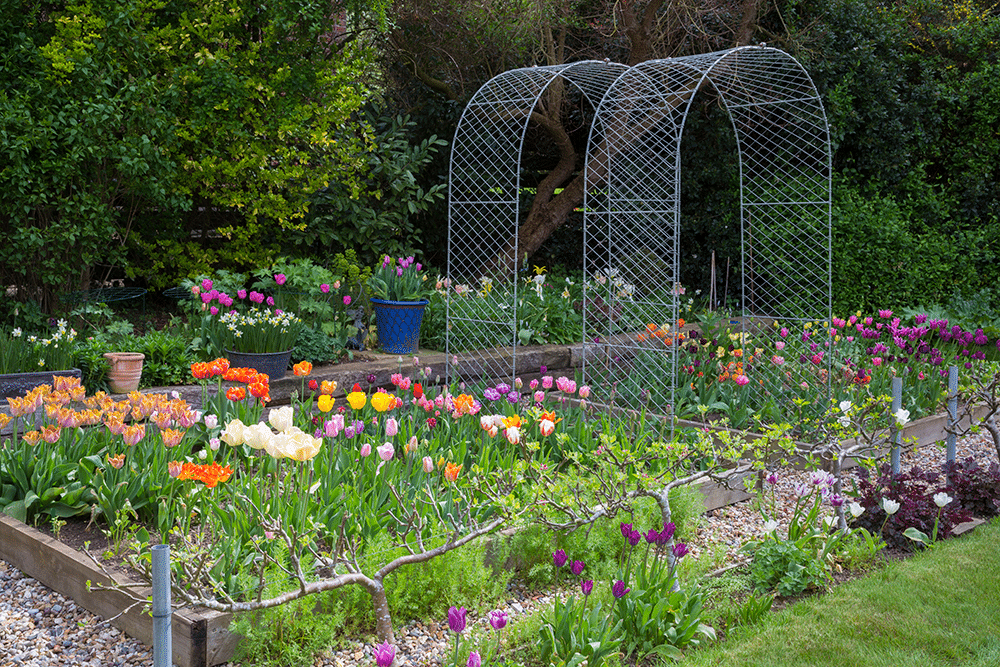
These versatile flowers serve as focal points while creating visual interest and drawing the eye. Perfectly shaped to attract pollinators as they contribute to a healthy backyard ecosystem.
Persian Lily
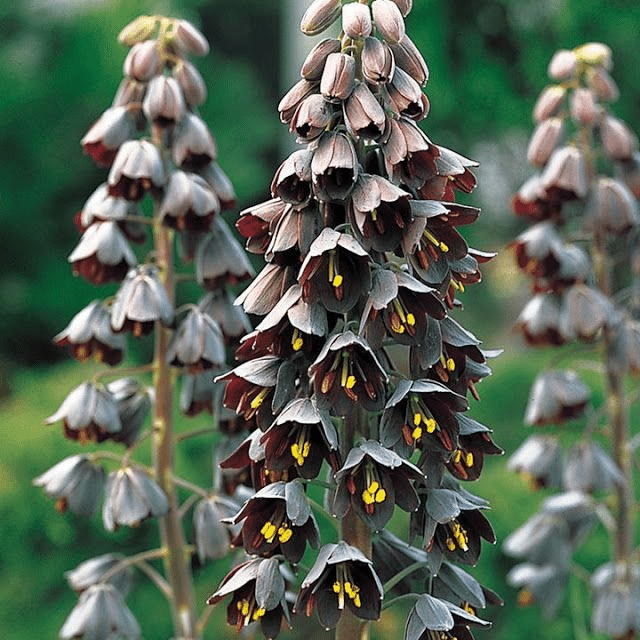
Fritillaria persica, also known as Persian lily is tall in stature with loosely hanging bell-shaped flowers in deep shades of purple. Its unique appearance, long blooming period, and ease of cultivation make it a delightful choice for adding a touch of elegance and drama to landscapes and floral arrangements alike.
Flower Basics
Botanical Name: Fritillaria persica
Color: Commonly purple, maroon, burgundy, and deep plum
Growing Zone: Zones 5 – 8
Annual or Perennial: Perennial plant
Sun: Full sun to partial shade
Water: Moderately moist
Flower Appearance
Fritillaria persica is a tall and majestic perennial flower with large, pendulous, and bell-shaped blooms in shades of deep purple. It grows from a bulb and reaches heights of 3 to 4 feet with sturdy stems. This captivating flower serves as a focal point in gardens, emerging in early spring and providing an impressive floral display before the foliage dies back. Take note that it has a distinct musky odor that may not be appealing to everyone.
Why Choose this Flower?
Fritillaria persica, or Persian lily, are purple bell shaped flowers that offers unique and visually captivating blooms in deep purple. It has a long blooming period, making it a great choice for extended displays in gardens and floral arrangements. With its cut flower potential, low maintenance requirements, and resistance to pests, it is an attractive addition to any garden.
Blue Bell
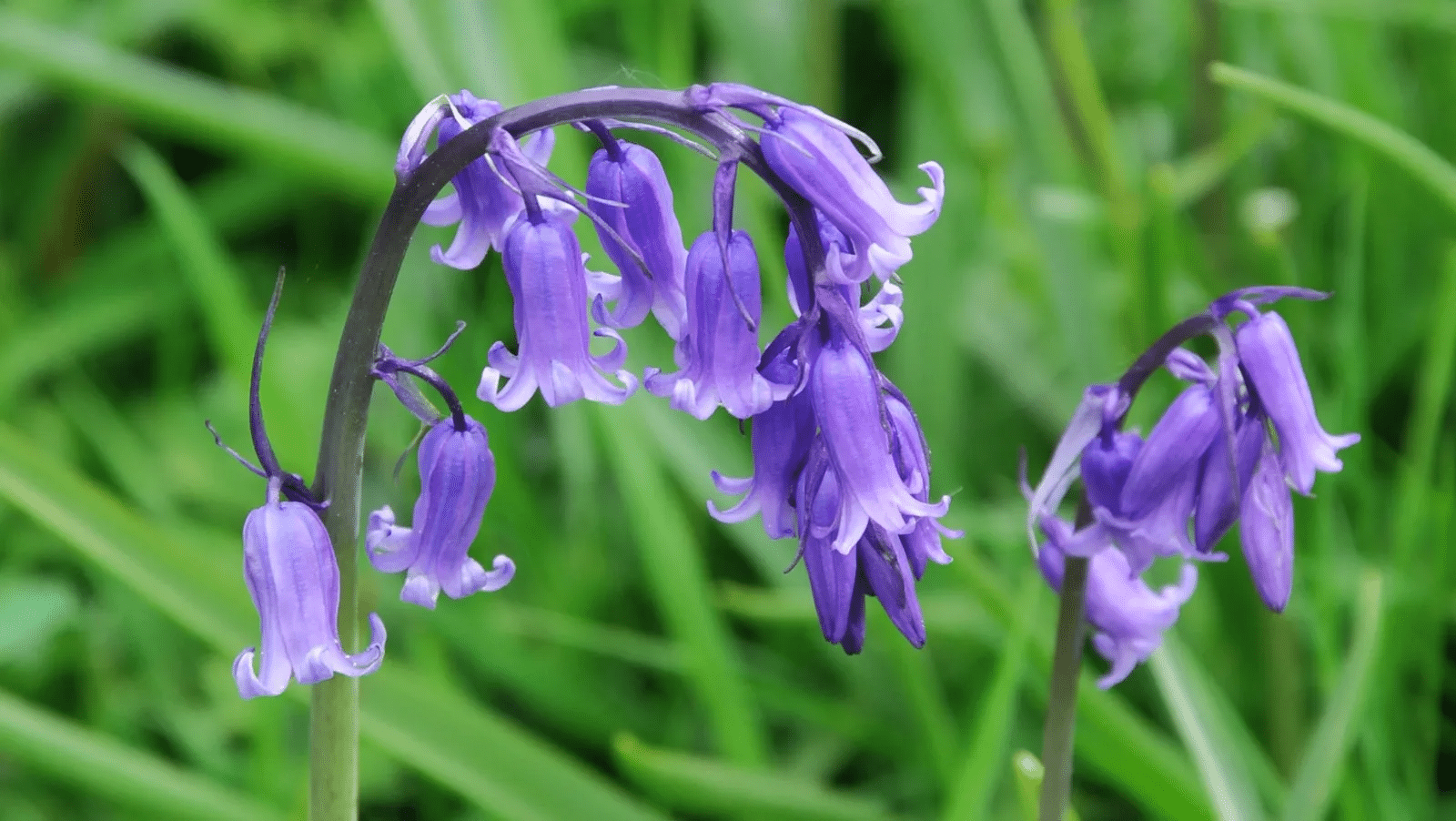
Flower Basics
Botanical Name: Hyacinthoides non-scripta
Color: Blue, violet, or white
Growing Zone: Zones 3-9
Annual or Perennial: Perennial plant
Sun: Partial shade to full shade
Water: Moderate water requirements
Flower Appearance
Bluebells are charming, bell-shaped flowers that grow on slender stalks. They feature drooping clusters of tubular-shaped blooms in shades of blue, violet, or white. The flowers hang delicately from the stems and create a carpet of color when they bloom in spring. Bluebells typically reach a height of 12 to 18 inches and form dense colonies over time.
Why Choose this Flower?
Bluebells are an excellent choice for those seeking bell-shaped flowers for their garden. They bring natural and enchanting beauty to any landscape. Bluebells are relatively easy to grow and maintain, making them suitable for gardeners of all levels.
They also attract pollinators like bees, providing a valuable food source. Bluebells are ideal for woodland gardens, shade gardens, or naturalized areas, and they can be used as cut flowers to create charming floral arrangements.
Lily of the Valley
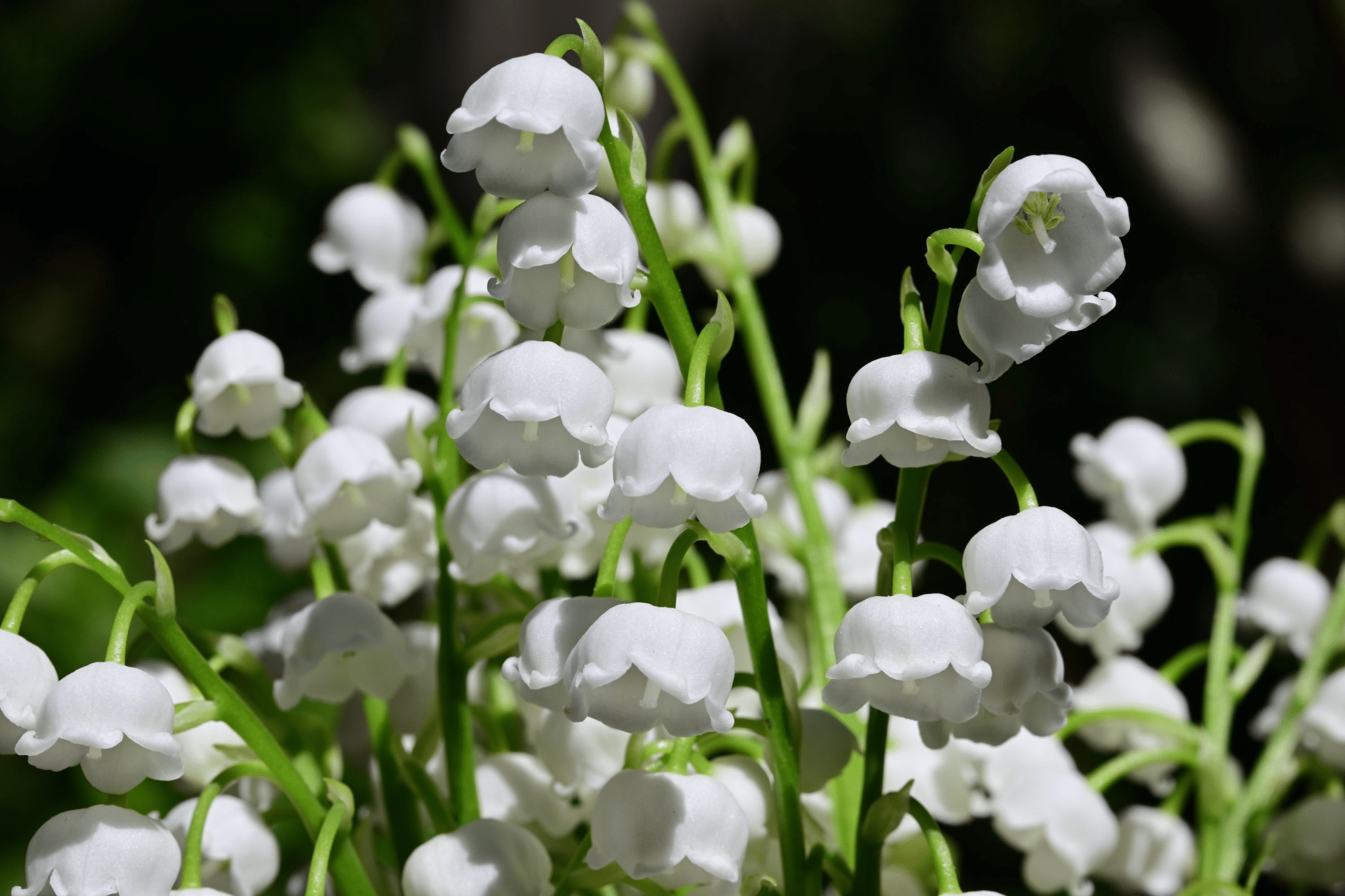
Flower Basics
Botanical Name: Convallaria majalis
Color: White
Growing Zone: Zones 2-7
Annual or Perennial: Perennial plant
Sun: Part shade to full shade
Water: Moderate water requirements
Flower Appearance
Lily of the Valley is a dainty, bell-shaped flower that grows on arching stems. It features clusters of small, fragrant, white blooms that hang downward. The flowers are complemented by lance-shaped, glossy green leaves. Lily of the Valley grows to a height of about 6 to 8 inches and spreads slowly to form a dense ground cover.
Why Choose this Flower?
Lily of the Valley (Convallaria majalis) is an excellent choice for your garden due to its enchanting fragrance, elegant appearance, shade tolerance, low maintenance requirements, and the ability to serve as a ground cover. It's also a good choice for its symbolic meanings and attractiveness to pollinators which further add to its appeal.
Campanula Bellflower
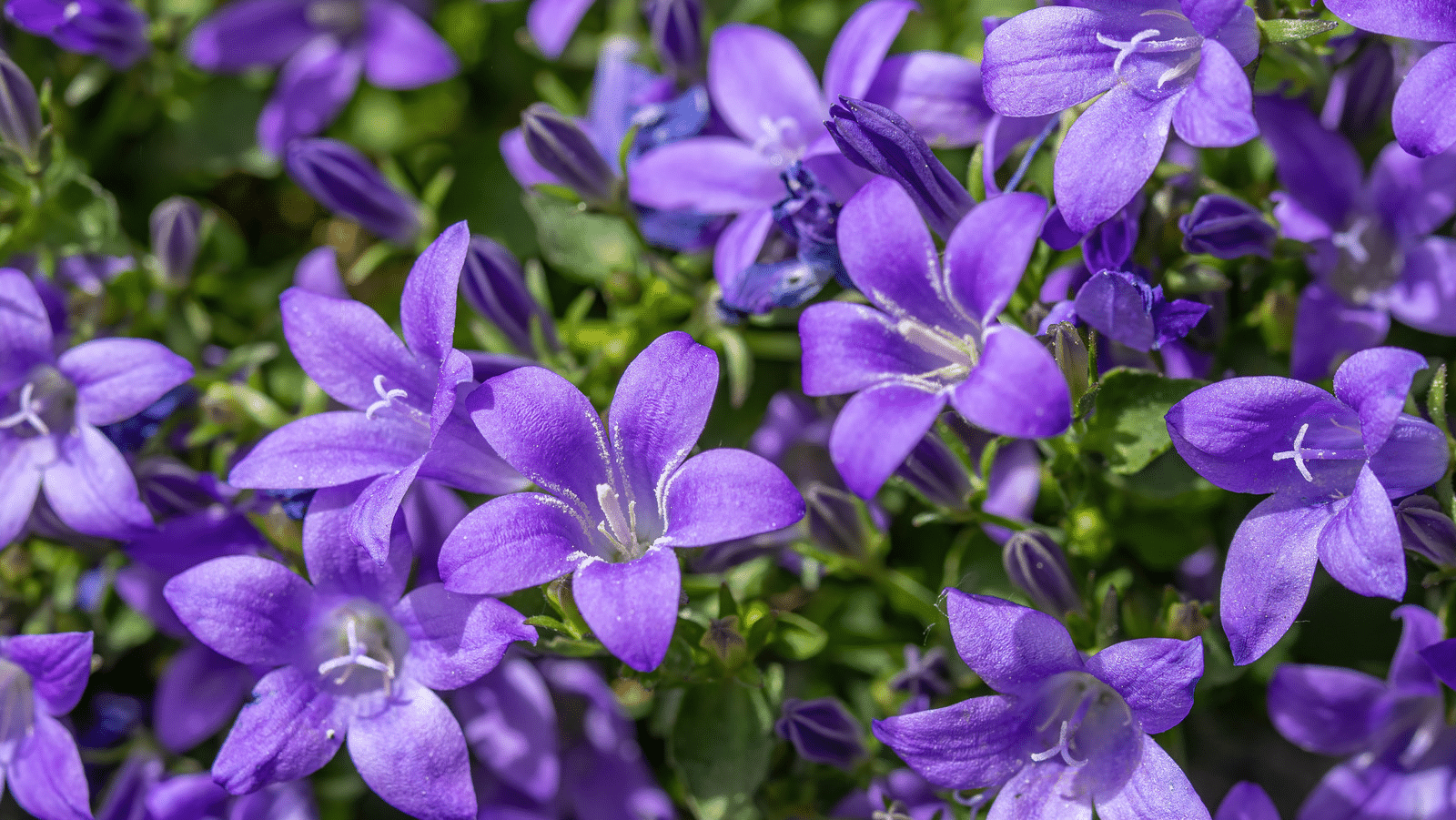
Flower Basics
Botanical Name: Campanula species (various)
Color: Varies (blue, purple, white, pink)
Growing Zone: Varies depending on species, 3-10
Annual or Perennial: Mostly perennial plants, some annual varieties
Sun: Full sun to partial shade
Water: Moderate water requirements
Flower Appearance
Campanula Bellflowers encompass a wide range of species and cultivars, but they all share the characteristic bell-shaped flowers. These flowers can come in various colors, including blue, purple, white, and pink. The growth habit varies depending on the species, with some forming mounds, others trailing, and some growing upright. Heights can range from a few inches to several feet, depending on the variety.
Why Choose this Flower?
Campanula bellflower is a fantastic low-maintenance choice for your garden due to its charming bell-shaped flowers, a wide range of colors, and graceful appearance. It is a versatile plant that can be used in various garden styles and is known for attracting pollinators in sun and partial shade.
Foxglove

Flower Basics
Botanical Name: Digitalis purpurea
Color: Various shades of pink, purple, white, or yellow
Growing Zone: Zones 4-10
Annual or Perennial: Biennial or short-lived perennial plant
Sun: Part sun to full shade
Water: Moderate water requirements
Flower Appearance
Foxglove is known for its tall spikes adorned with tubular, bell-shaped flowers. The flowers can be found in shades of pink, purple, white, or yellow, often with speckled or spotted markings inside. The plant reaches heights of 3 to 6 feet and showcases a rosette of dark green, lance-shaped leaves at the base.
Why Choose this Flower?
Foxglove (Digitalis purpurea) is a captivating bell-shaped flower that offers unique characteristics. With its tall spires of bell-shaped flowers in various shades of pink, purple, white, and yellow, Foxglove adds striking visual appeal to any garden., Foxglove brings a touch of charm, pollinator attraction, and unique blooming behavior to garden landscapes.
Harebell
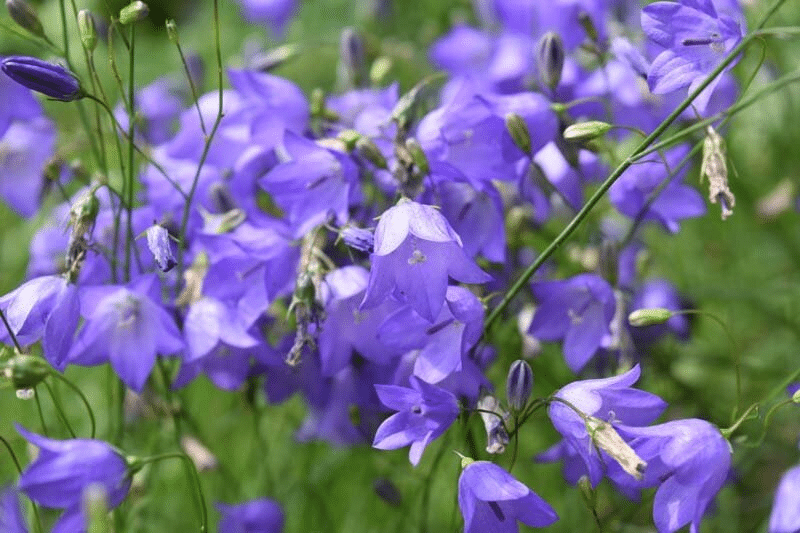
Flower Basics
Botanical Name: Campanula rotundifolia
Color: Blue-violet or white
Growing Zone: Zones 3-7
Annual or Perennial: Perennial plant
Sun: Full sun to part shade
Water: Low to moderate water requirements
Flower Appearance
Harebell, also known as the Scottish Bluebell, produces delicate, bell-shaped flowers. The blossoms come in shades of blue-violet or white and hang from slender stems. The plant forms clumps of slender, wiry stems that reach a height of about 8 to 20 inches. Harebell is a charming addition to rock gardens and cottage-style landscapes.
Why Choose this Flower?
Harebell (Campanula rotundifolia) is an excellent choice for your garden with its delicate and charming bell-shaped flowers that range in color from pale blue to violet. This perennial plant has a trailing growth habit and reaches a height of about 12 to 18 inches (30 to 45 cm), making it ideal for rock gardens, borders, or containers.
Harebell is easy to grow, tolerates various soil conditions, and attracts pollinators like bees and butterflies, adding life and movement to your garden.
Canterbury Bells
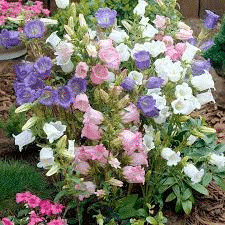
Flower Basics
Botanical Name: Campanula medium
Color: Various shades of blue, pink, white, or purple
Growing Zone: Zones 4-10
Annual or Perennial: Biennial or short-lived perennial plant
Sun: Full sun to part shade
Water: Moderate water requirements
Flower Appearance
Canterbury Bells are known for their large, bell-shaped flowers that come in a range of colors, including blue, pink, white, and purple. The flowers are clustered on sturdy stems, and the plant can reach heights of 2 to 4 feet. Canterbury Bells make stunning additions to cottage gardens and mixed borders.
Why Choose this Flower?
Canterbury Bells (Campanula medium) is a showy biennial or short-lived perennial plant known for its large, bell-shaped flowers that come in a wide range of colors, including blue, pink, purple, and white. Growing up to 2 to 3 feet (60 to 90 cm) in height, Canterbury Bells make a bold statement in the garden and are often used as cut flowers due to their long, sturdy stems. They prefer full sun to partial shade and well-draining soil, and with proper care, they can bloom profusely in late spring or early summer.
Fritillaria meleagris (Snake's Head Fritillary)
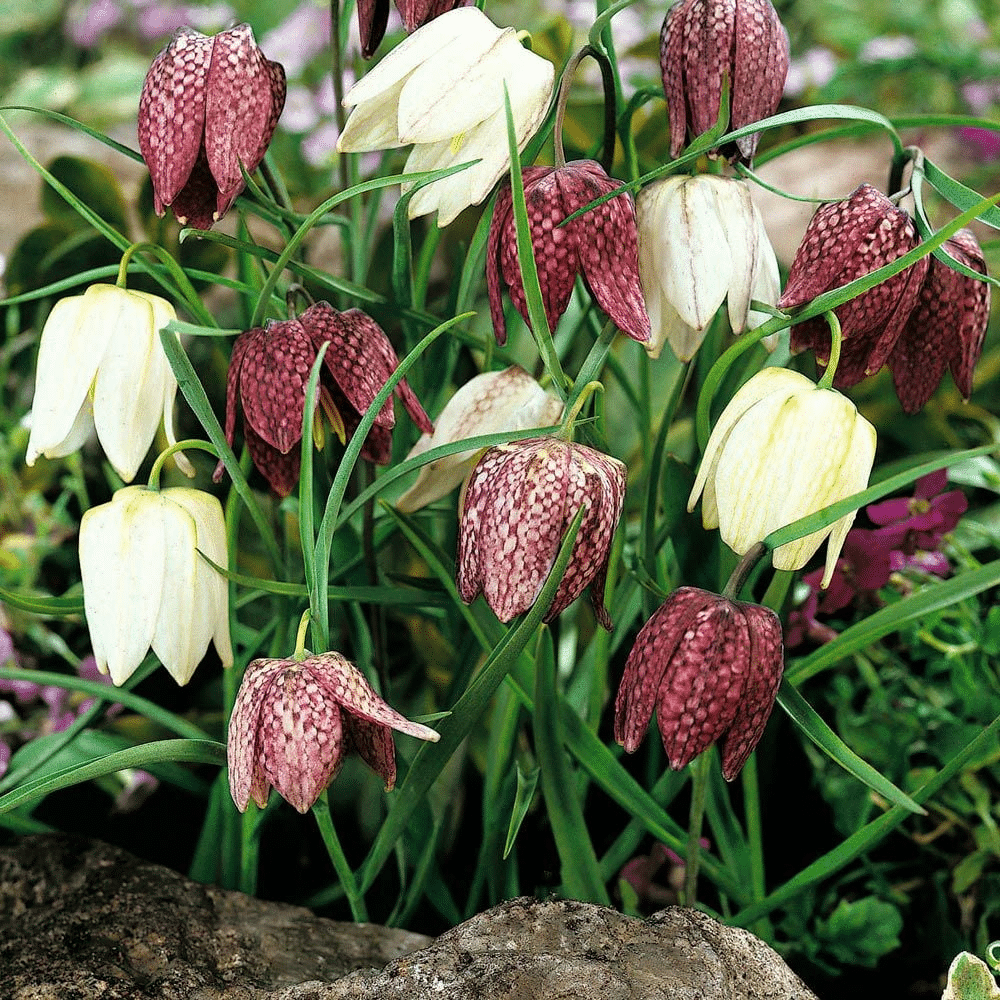
Flower Basics
Botanical Name: Fritillaria meleagris
Color: Checkered pattern of purple, white, pink, or maroon
Growing Zone: Zones 4-8
Annual or Perennial: Perennial plant
Sun: Full sun to part shade
Water: Moderate water requirements
Flower Appearance
Fritillaria meleagris, commonly known as Snake's Head Fritillary, displays unique bell-shaped flowers with a checkered pattern in shades of purple, white, pink, or maroon. The nodding flowers hang from slender stems and bloom in early spring. The plant grows to a height of about 8 to 12 inches and thrives in moist, well-drained soil.
Why Choose this Flower?
Fritillaria meleagris, also known as Snake's Head Fritillary, is a unique and captivating bell-shaped flower. Native to Europe, this perennial plant features bell-shaped flowers with a distinctive checkerboard pattern in shades of purple, pink, or white. Growing up to 12 to 16 inches in height Its unusual and eye-catching appearance makes it a popular choice for naturalizing in meadows or woodland gardens.
Trumpet Vine
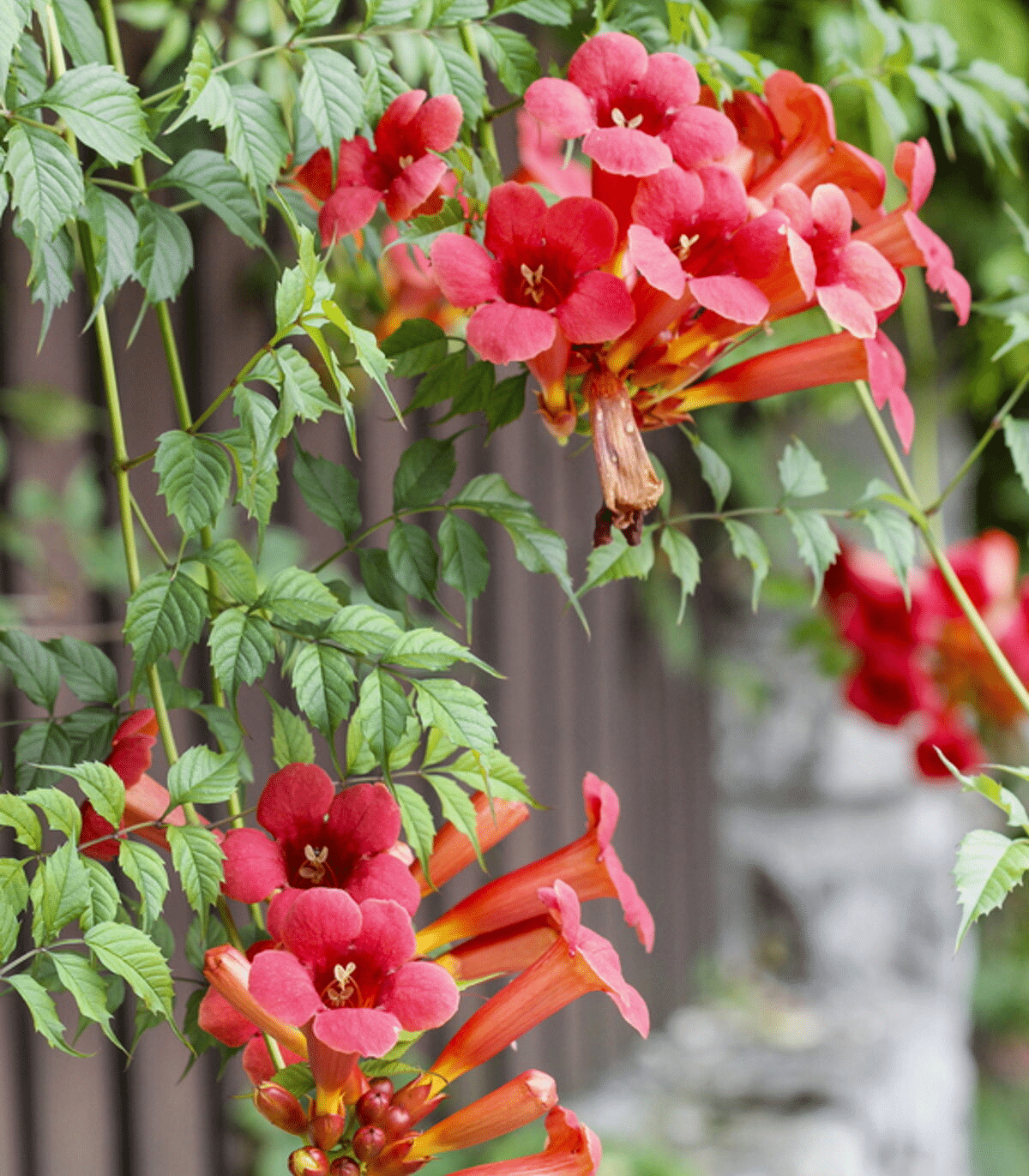
Flower Basics
Botanical Name: Campsis radicans
Color: Orange-red or yellow
Growing Zone: Zones 4-9
Annual or Perennial: Perennial vine
Sun: Full sun
Water: Moderate water requirements
Flower Appearance
Trumpet Vine produces showy, trumpet-shaped flowers in shades of orange-red or yellow. The flowers hang in clusters and attract hummingbirds with their nectar. As a vigorous climbing vine, it can reach heights of 30 feet or more. Trumpet Vine thrives and is an excellent choice for adding vertical interest to garden fences, arbors, or trellises.
Why Choose this Flower?
Trumpet Vine (Campsis radicans) is a vigorous and fast-growing vine that produces stunning trumpet-shaped flowers in vibrant shades of red, orange, or yellow. The large, showy flowers attract hummingbirds and butterflies, adding a lively touch to your garden. It thrives in full sun and well-draining soil, and once established, it is drought-tolerant and requires minimal maintenance.
Columbine

Flower Basics
Botanical Name: Aquilegia species (various)
Color: Various colors including blue, pink, yellow, purple, and white
Growing Zone: Varies depending on species
Annual or Perennial: Perennial plant
Sun: Full sun to part shade
Water: Moderate water requirements
Flower Appearance
Columbine is characterized by its unique, bell-shaped flowers that have distinctive spurred petals. The flowers can be found in various colors, including blue, pink, yellow, purple, and white. The plant forms clumps of attractive foliage and reaches a height of about 1 to 3 feet. Columbine is well-suited for cottage gardens and woodland settings.
Why Choose this Flower?
Columbine (Aquilegia) is a graceful and elegant perennial flower that features bell-shaped flowers with distinctive spurs. Columbine adds a charming touch to any garden. It prefers partial shade to full sun and well-draining soil. Columbine blooms in late spring to early summer and attracts pollinators such as bees and butterflies.
Gloxinia
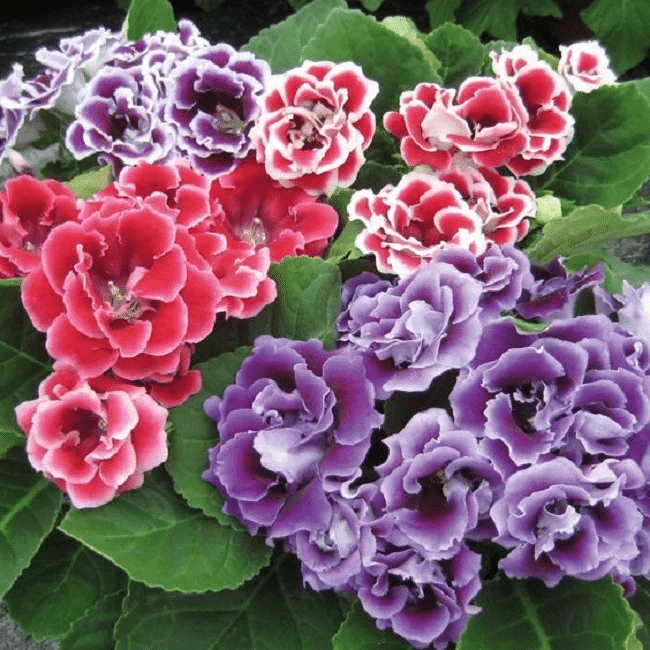
Flower Basics
Botanical Name: Sinningia speciosa
Color: Various colors including purple, pink, red, and white
Growing Zone: Zones 10-11 (often grown as a houseplant)
Annual or Perennial: Perennial plant (often grown as an annual or houseplant)
Sun: Part shade to filtered light
Water: Moderate water requirements
Flower Appearance
Gloxinia produces exquisite, bell-shaped flowers that come in a range of colors, including purple, pink, red, and white. The velvety flowers have a tubular shape and may feature ruffled or fringed edges. Gloxinia is often grown as a houseplant due to its preference for warm, humid environments. It can reach a height of 6 to 12 inches and is known for its stunning floral display.
Why Choose this Flower?
Gloxinia (Sinningia speciosa) is a tropical perennial plant with bell-shaped flowers that come in an array of vibrant colors that can add a touch of exotic beauty to indoor spaces. It can be grown indoors and outdoors and with proper care can bloom year-round.
White Mountain Heather
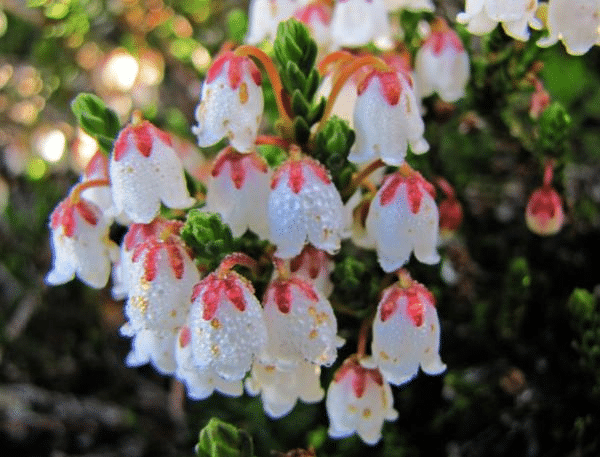
Flower Basics
Botanical Name: Cassiope species (various)
Color: White or pink
Growing Zone: Varies depending on species
Annual or Perennial: Perennial plant
Sun: Full sun to part shade
Water: Low to moderate water requirements
Flower Appearance
White Mountain Heather, belonging to the Cassiope genus, produces bell-shaped flowers in clusters. The flowers can be white or pink, and they often have a delicate and graceful appearance. The plant forms compact mounds of evergreen foliage and typically grows to a height of 6 to 12 inches. White Mountain Heather thrives in well-drained, acidic soils and is well-suited for rock gardens and alpine settings.
Why Choose this Flower?
White Mountain Heather (Cassiope tetragona) is an evergreen shrub that produces bell-shaped flowers in clusters. Native to mountainous regions, this low-growing plant is prized for its delicate beauty and hardiness.
White Mountain Heather blooms in late spring to early summer while Its compact form and tolerance to harsh conditions make it an excellent choice for rock gardens, slopes, or alpine-inspired landscapes.
Lady's Slipper Orchid

Flower Basics
Botanical Name: Cypripedium species (various)
Color: Various colors including pink, white, yellow, and purple
Growing Zone: Varies depending on species
Annual or Perennial: Perennial plant
Sun: Part shade to full shade
Water: Moderate water requirements
Flower Appearance
Lady's Slipper Orchids are renowned for their unique and intricate flowers, which often resemble a slipper or pouch. The flowers can be found in various colors, including pink, white, yellow, and purple, depending on the species. Lady's Slipper Orchids grow from terrestrial roots and display elegant blooms that make them highly sought after by orchid enthusiasts and collectors.
Why Choose this Flower?
Lady's Slipper Orchid (Cypripedium) is a group of terrestrial orchids that produce stunning bell-shaped flowers with pouch-like petals. These orchids come in various colors, including shades of pink, purple, yellow, and white.
Lady's Slipper Orchids are known for their exquisite beauty and rarity, making them highly sought after by orchid enthusiasts. While they require specific care and conditions, the reward of growing these unique and elegant bell-shaped flowers in bloom is truly special.
Beardtongue

Flower Basics
Botanical Name: Penstemon species (various)
Color: Various colors including red, pink, purple, blue, and white
Growing Zone: Zones 3-8
Annual or Perennial: Perennial plant
Sun: Full sun to part shade
Water: Low to moderate water requirements
Flower Appearance
Penstemon, commonly known as Beardtongue, features tubular, bell-shaped flowers that come in a variety of colors, including red, pink, purple, blue, and white. The flowers are often adorned with contrasting markings or patterns. Penstemon plants vary in size and growth habits, ranging from compact mounds to tall spikes.
Why Choose this Flower?
Penstemon (Beardtongue) is a diverse genus of perennial flowers that includes numerous species with bell-shaped blooms. The flowers can vary in color, including shades of pink, purple, blue, red, and white. Penstemon plants have upright growth habits and reach heights of 1 to 3 feet, depending on the species.
They thrive in full sun to partial shade and well-draining soil. Penstemons are known for their attractive tubular flowers that are favored by hummingbirds, making them a wonderful choice for wildlife-friendly gardens.
Daffodil
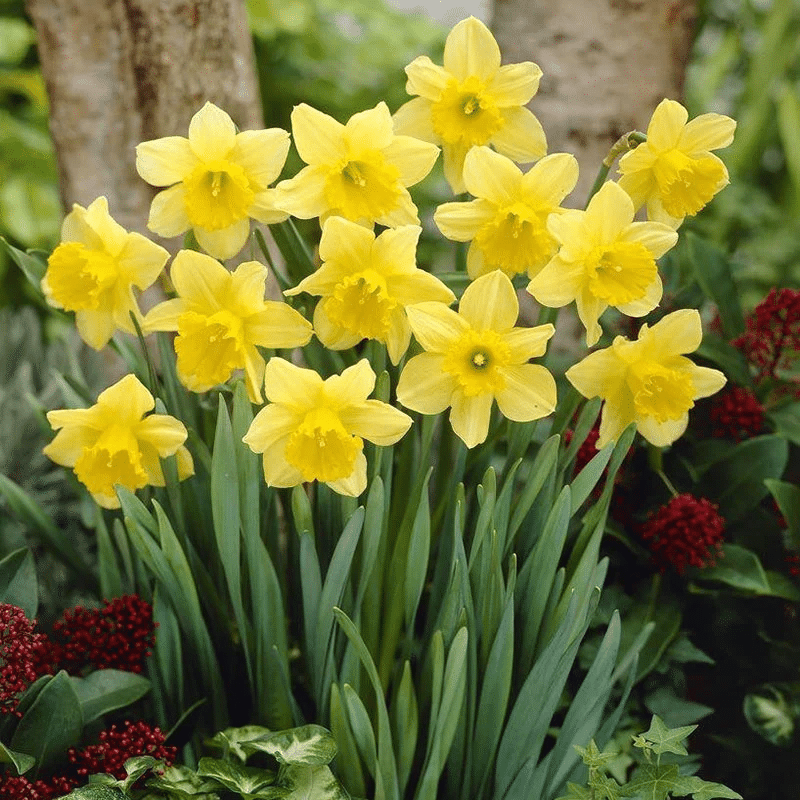
Flower Basics
Botanical Name: Narcissus species (various)
Color: Various colors including yellow, white, orange, and pink
Growing Zone: Varies depending on species
Annual or Perennial: Perennial bulb
Sun: Full sun to part shade
Water: Moderate water requirements
Flower Appearance
Daffodils, a type of Narcissus, are beloved for their cheerful, trumpet-shaped flowers. They come in various colors, including shades of yellow, white, orange, and pink. Daffodils grow from bulbs and produce long, slender stems topped with a single flower or clusters of blooms. The flowers are often accompanied by strap-like leaves. Daffodils are early bloomers, signaling the arrival of spring and adding a burst of color to gardens and landscapes.
Why Choose this Flower?
Daffodil (Narcissus) is a classic and beloved spring-flowering bulb that produces charming bell-shaped flowers. They are known for their trumpet-shaped central cup surrounded by petals. Daffodils prefer full sun to partial shade and well-draining soil. These reliable and low-maintenance flowers are among the first to bloom in spring, bringing a burst of color and cheerfulness to gardens and landscapes.
Bell Shaped Flowers Conclusion
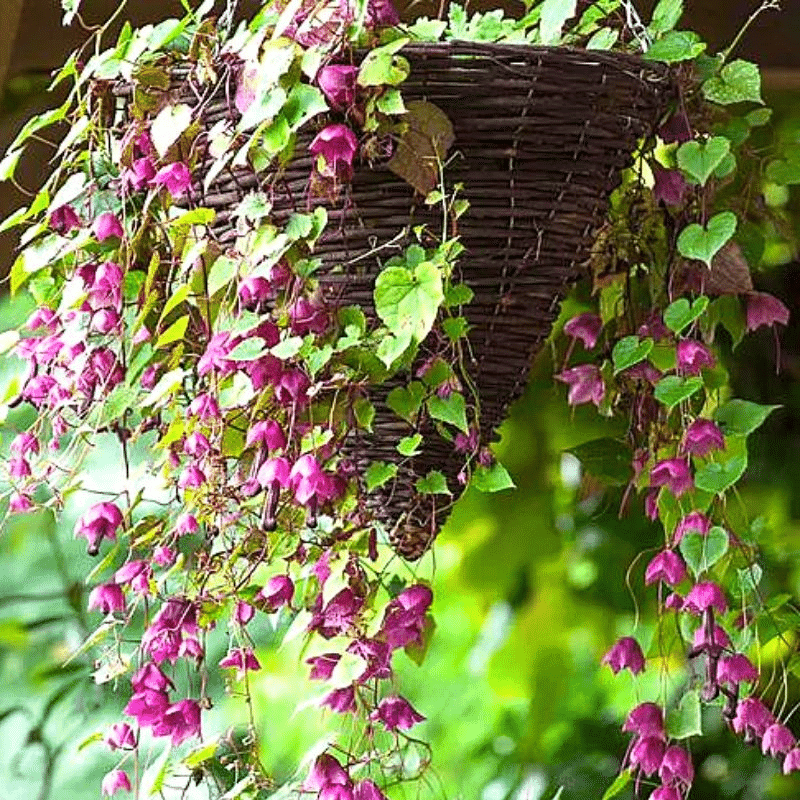
Bell-shaped flowers offer a range of desirable qualities that make them an excellent choice for gardens. Their graceful aesthetic appeal, versatile design possibilities, attraction for pollinators, and diverse flower options make them a popular and rewarding addition to any garden. Whether you choose the enchanting Lily of the Valley, the majestic Persian Lily, the delicate Campanula Bellflower, or any other bell-shaped flower, you can enhance your garden with its unique beauty and enjoy the numerous benefits they bring.

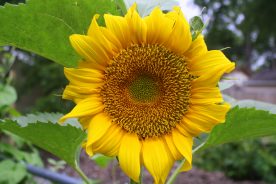
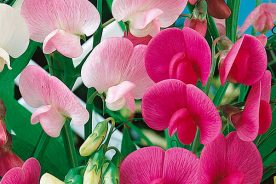
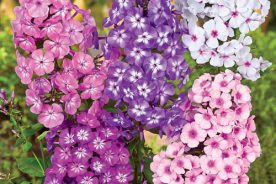

No Comments